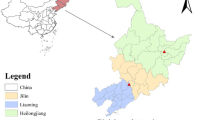Abstract
In this study, compatible taper and stem volume equations were developed for Larix kaempferi species of South Korea. The dataset was split into two groups: 80% of the data were used in model fitting and the remaining 20% were used for validation. The compatible MB76 equations were used to predict the diameter outside bark to a specific height, the height to a specific diameter and the stem volume of the species. The result of the stem volume analysis was compared with the existing stem volume model of Larix kaempferi species of South Korea which was developed by the Korea Forest Research Institute and with a simple volume model that was developed with fitting dataset in this study. The compatible model provided accurate prediction of the total stem volume when compared to the existing stem volume model and with a simple volume model. It is concluded that the compatible taper and stem volume equations are more convenient to use and therefore it is recommended to be applied in the Larix kaempferi species of South Korea.
Similar content being viewed by others
References
Bi H (2000) Trigonometric variable-form taper equations for Australian Eucalyptus. Forest Science 46(3): 397–409.
Brooks J, Jiang L, Özçelik R (2008) Compatible stem volume and taper equations for Brutian pine, Cedar of Lebanon, and Cilicica fir in Turkey. Forest Ecology and Management 256(1): 147–151. DOI: 10.1016/j.foreco.2008.04.018
Brooks J, Martin S, Jordan J, and Sewell C (2002) Interim taper and cubic-foot volume equations for young Longleaf pine plantations in Southwest Georgia. In: General Technical Report SRS–48. Asheville, North Carolina: United States, Department of Agriculture, Forest Service, Southern Research Station. pp 467–470.
Brooks J (2001) Interim volume tables for Atlantic White cedar. The Consultant Winter 46(1): 24–28.
Burkhart H (2016) Comments on the three comparative analyses of stem taper models published in Journal of Mountain Science in 2014-2016. Journal of Mountain Science 13(3): 534–535. DOI: 10.1007/S11629-016-3842-5
Burkhart H, Tomé M (2012) Modeling forest trees and stands. Springer Science +Business Media Dordrecht. pp 33–35. DOI: 10.1007/978-90-481-3170-9_2
Coble D, Hilpp K (2006) Compatible cubic-foot stem volume and upper-stem diameter equations for semi intensive plantation grown Loblolly pine trees in East Texas. Southern Journal of Applied Forestry 30(3): 132–141.
Clark III A, Souter R, Schlaegel B (1991) Stem profile equations for Southern tree species. USDA Forest Service Research Paper SE. p 282.
Czaplewski R, Bruce D (1990) Retransformation bias in a stem profile model. Canadian Journal of Forest Research 20(10): 1623–1630. DOI: 10.1139/x90-215
Jiang L, Brooks JR, Wang J (2005) Compatible taper and volume equations for Yellow-Poplar in West Virginia. Forest Ecology and Management 213(1): 399–409. DOI: 10.1016/j.foreco.2005.04.006
Korea Forest Research Institute (2012) Estimation of tree volume, biomass and stand yield table. Korea Forest Research Institute. Seoul, Korea. (In Korean)
Kozak A (1988) A variable-exponent taper equation. Canadian Journal of Forest Research 18(11): 1363–1368. DOI: 10.1139/x88-213
Kozak A (2004) My last words on taper equations. The Forest Chronicle 80(4): 507–515. DOI: 10.5558/tfc80507-4
Lee W, Seo J, Son Y, et al. (2003) Modeling stem profiles for Pinus densiflora in Korea. Forest Ecology and Management 172(1): 69–77. DOI: 10.1016/S0378-1127(02)00 139-1
Li R, Weiskittel A, Dick A, et al. (2012) Regional stem taper equations for eleven conifer species in the Acadian Region of North America: Development and Assessment. Northern Journal of Applied Forestry 29(1): 5–14. DOI: 10.5849/njaf.10-037
Lumbres R, Abino A, Pampolina N, et al. (2016) Comparison of stem taper models for the four tropical tree species in Mount Makiling, Philippines. Journal of Mountain Science 13(3): 536–545. DOI: 10.1007/s11629-015-3546-2
Martin J (1981) Taper and volume equations for selected Appalachian hardwood species. United States Department of Agriculture. Forest Service. Research paper NE-490.
Max T, Burkhart H (1976) Segmented polynomial regression applied to taper equations. Forest Science 22(3): 283–289.
Özçelik R, Göçeri M (2015) Compatible merchantable stem volume and taper equations for Eucalyptus plantations in the Eastern Mediterranean Region of Turkey. Turkish Journal of Agriculture and Forestry 39(6): 851–863. DOI: 10.3906/tar-1501-27
Özçelik R, Brooks J (2012) Compatible volume and taper models for economically important tree species of Turkey. Annals of Forest Science 69(1): 105–118. DOI: 10.1007/s13595-011-0137-4
Rojo A, Perales X, Sanchez-Rodriguez F, et al. (2005) Stem taper functions for Maritime pine (Pinus pinaster Ait.) in Galicia (Northwestern Spain). European Journal of Forest Research 124(3): 177–186. DOI: 10.1007/S10342-005-0066-6
SAS Institute Inc. (2004) SAS/STAT 9.1 User’s Guide. SAS Institute Inc., Cary. NC, USA.
Son Y, Lee K, Lee W, Kwon S (2002) Stem taper equations for six major tree species in Korea. Journal of Korean Forest Society 91(2): 213–218. (In Korean with English abstract)
Teshome T (2005) Compatible volume-taper equations for predicting merchantable volume to variable merchantable limits for Cuppressus lusitanica, Ethiopia. Ethiopian Journal of Science 28(1): 15–22. DOI: 10.4314/sinet.v28i1.18227
Williams M, Reich R (1997) Exploring the error structure of taper equations. Forest science 43(3): 378–386.
Acknowledgments
The authors would like to express their gratitude to the Korea Forest Service for funding this research (Project No. S211316L020130).
Author information
Authors and Affiliations
Corresponding author
Additional information
http://orcid.org/0000-0001-9392-5640
http://orcid.org/0000-0002-9319-1533
http://orcid.org/0000-0001-9175-6388
http://orcid.org/0000-0002-5508-3953
http://orcid.org/0000-0002-4277-3082
Rights and permissions
About this article
Cite this article
Doyog, N.D., Lee, Y.J., Lee, S.J. et al. Compatible taper and stem volume equations for Larix kaempferi (Japanese larch) species of South Korea. J. Mt. Sci. 14, 1341–1349 (2017). https://doi.org/10.1007/s11629-016-4291-x
Received:
Revised:
Accepted:
Published:
Issue Date:
DOI: https://doi.org/10.1007/s11629-016-4291-x




